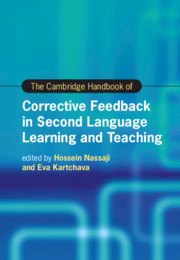Book contents
- The Cambridge Handbook of Corrective Feedback in Second Language Learning and Teaching
- Cambridge Handbooks in Language and Linguistics
- The Cambridge Handbook of Corrective Feedback in Second Language Learning and Teaching
- Copyright page
- Contents
- Figures
- Tables
- Contributors
- Acknowledgments
- Introduction Corrective Feedback in Second Language Teaching and Learning
- Part I Theoretical Perspectives on Corrective Feedback
- Part II Methodological Approaches in the Study of Corrective Feedback
- Part III Different Delivery Modes of Corrective Feedback
- Part IV Feedback Provider, Feedback Intensity, and Feedback Timing
- Part V Corrective Feedback and Language Skills
- Part VI Contexts of Corrective Feedback and Their Effects
- Part VII Learners’ and Teachers’ Feedback Perspectives, Perceptions, and Preferences
- Part VIII Individual Differences, Tasks, and Other Language- and Learner-Related Factors
- 30 Age and Corrective Feedback
- 31 Gender Effects
- 32 Feedback, Aptitude, and Multilingualism
- 33 Corrective Feedback and Affect
- 34 Corrective Feedback, Developmental Readiness, and Language Proficiency
- 35 Corrective Feedback and Grammatical Complexity: A Research Synthesis
- 36 The Role of Task in the Efficacy of Corrective Feedback
- Index
- References
32 - Feedback, Aptitude, and Multilingualism
from Part VIII - Individual Differences, Tasks, and Other Language- and Learner-Related Factors
Published online by Cambridge University Press: 26 February 2021
- The Cambridge Handbook of Corrective Feedback in Second Language Learning and Teaching
- Cambridge Handbooks in Language and Linguistics
- The Cambridge Handbook of Corrective Feedback in Second Language Learning and Teaching
- Copyright page
- Contents
- Figures
- Tables
- Contributors
- Acknowledgments
- Introduction Corrective Feedback in Second Language Teaching and Learning
- Part I Theoretical Perspectives on Corrective Feedback
- Part II Methodological Approaches in the Study of Corrective Feedback
- Part III Different Delivery Modes of Corrective Feedback
- Part IV Feedback Provider, Feedback Intensity, and Feedback Timing
- Part V Corrective Feedback and Language Skills
- Part VI Contexts of Corrective Feedback and Their Effects
- Part VII Learners’ and Teachers’ Feedback Perspectives, Perceptions, and Preferences
- Part VIII Individual Differences, Tasks, and Other Language- and Learner-Related Factors
- 30 Age and Corrective Feedback
- 31 Gender Effects
- 32 Feedback, Aptitude, and Multilingualism
- 33 Corrective Feedback and Affect
- 34 Corrective Feedback, Developmental Readiness, and Language Proficiency
- 35 Corrective Feedback and Grammatical Complexity: A Research Synthesis
- 36 The Role of Task in the Efficacy of Corrective Feedback
- Index
- References
Summary
Aptitude and language experience (i.e., multilingualism) are two individual differences that have attracted increasing interest in the field of second language acquisition. This chapter looks at the role that aptitude and multilingualism play on language learning under different pedagogical conditions, and specifically with different forms of feedback. Questions that we try to answer are: Do learners with high cognitive aptitudes and language experience benefit more from corrective feedback than those with low cognitive aptitudes and language experience? What cognitive aptitudes benefit learning when receiving implicit vs. explicit feedback? What type of feedback is effective regardless of learners’ cognitive aptitudes and language experience? Results from laboratory and classroom research with adult learners suggest that the effects of feedback on language development are constrained by a number of cognitive aptitudes such as linguistic analytic ability and rote memory. Multilingualism seems to provide young adults with an advantage under conditions that do not include metalinguistic information during provision of feedback. For learners over 65, however, learning appears to be negatively affected by what they perceive as an excess of information during practice, i.e., when feedback includes information about how the language works, but not when that information is presented prior to practice.
Keywords
- Type
- Chapter
- Information
- The Cambridge Handbook of Corrective Feedback in Second Language Learning and Teaching , pp. 689 - 712Publisher: Cambridge University PressPrint publication year: 2021

